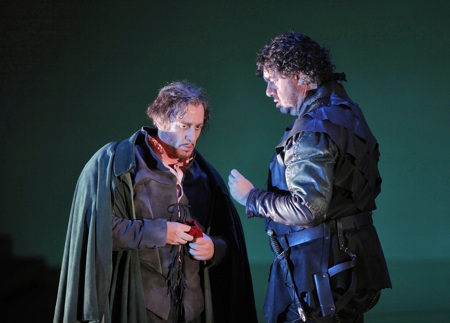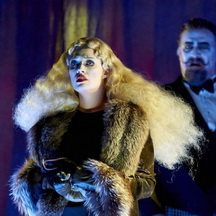Fools and Curses at the SF Opera
A lone trumpet set a fragile entrance in the darkened house, followed by melancholy horns. As the curtains rose, a spotlight shone down on a lump of limbs and bells, slowly defined by motion—the hunchbacked jester, Rigoletto. Masked revelers, frozen in the arches, were backlit in red. Leaning into the distance, colonnades mirrored the sharp disaffection and stark shadows of Di Chirico’s “Girl with a Hoop.”
Wonderfully atmospheric, the San Francisco Opera opened their new season with a veritable potboiler, Giuseppe Verdi’s Rigoletto. With two separate-but-equal casts sharing the bill, I was more than pleased by the second-night opening on Saturday, Sept 8, with tenor Arturo Chacón-Cruz as the bad-boy Duke—a duke whose delivery was so clear and liquid that it was easy to indulge his excesses.
Rigoletto and his daughter, Gilda, were sung convincingly by Margo Vratogna and Albina Shagimuratova. Vratogna’s inward-hued baritone suggested the jester’s tortured posture, not only bent by birth, but the twisted posture of those paid to mock others. Shagimuratova was dead on pitch in her highest notes, and her pianissimos were succulent. Active but disproportionate stage directions had her move from chair to chair and finally flop on the floor while singing “caro nome,” a gorgeous soprano aria that is difficult because it is so naked. With spare flute harmonies, the voice must display purity and inner depth in achingly slow steps and at a punishingly high tessitura. She managed much of that, and then iced the cake in a riveting final death aria… again, on her back!
In between, she was imprisoned by a doting dad, kidnapped, raped, re-imprisoned and… well, I wouldn’t want to spoil the story. While it would seem that she is flotsam in a bizarre tale of curses and vengeance, her passive power drives the plot, for all that it is hidden. Ultimately, her ability to love the man who wronged her, and her entreaties to forgive, become the crux of the story, while her father’s inability empowers the curse.
And that curse! The convoluted libretto, written by Francesco Maria Piave after Victor Hugo’s play, Le Roi s’amuse, points at poetic justice. Written sixty years after Mozart’s Don Giovanni, there are surprising parallels. But while Mozart’s opera portrayed a noble’s abuse of power and the divine retribution that drags him down to hell, Verdi lets his scoundrels go free. And in his treatment, that retribution (similarly derived from a death curse) targets the hunchbacked cat’s paw, not the author of the act.
It is thought that Mozart’s librettist, Lorenzo da Ponte, was describing the roots of the French Revolution, while, forty years later, Victor Hugo wrote against the re-introduction of monarchy in the form of Louis Philippe I. Hugo’s “blame-the-jester” is a curious disguise, one probably born of many years under the rule of the guillotine. Though Hugo’s play was banned for the next fifty years, this did not stop Verdi from popularizing the story in Italy.
In opera, one can make a strong brew from politics, vengeance and misplaced love—but only if the singing is credible. While this cast didn’t quite mesh, they came close. And adding believability to them was bass Andrea Silvestrelli, who played the assassin, Sparafucile. As a cutthroat with a strange code of honor, Silvestrelli added depth of character, just as he did in last year’s Ring Cycle when he brought grief, love and a voice of earth and stone to the role of the ice giant, Fasolt.
Completing the tone was magical lighting, sets that invoked the loneliness of Di Chirico’s canvases, and, of course, the music. Conducted by Nicola Luisotti, the SF Opera Orchestra was grand in Verdi’s bright and penumbral passages.
Not only does this powerful work continue at the opera house, but there will be a FREE live simulcast in San Francisco’s AT&T Park on Sept 15 at 8:00 p.m. See www.sfopera.com for details and for passes to this year’s “Opera at the Ballpark.”
—Adam Broner
Photo of Marco Vratogna as Rigoletto and Andrea Silvestrelli as Sparafucile in Rigoletto at the War Memorial Opera House; photo by Cory Weaver.
